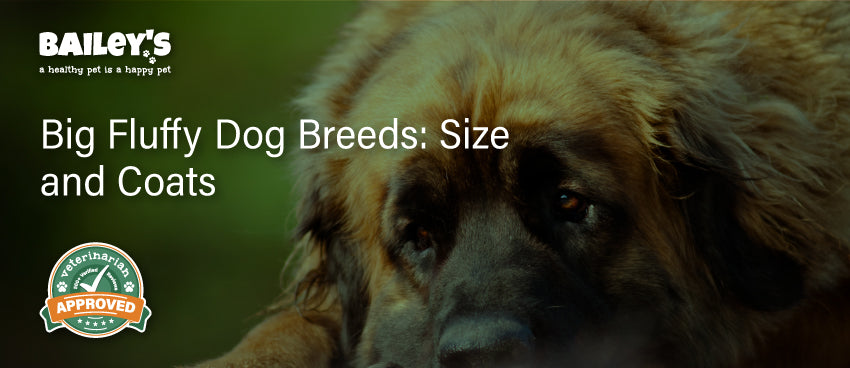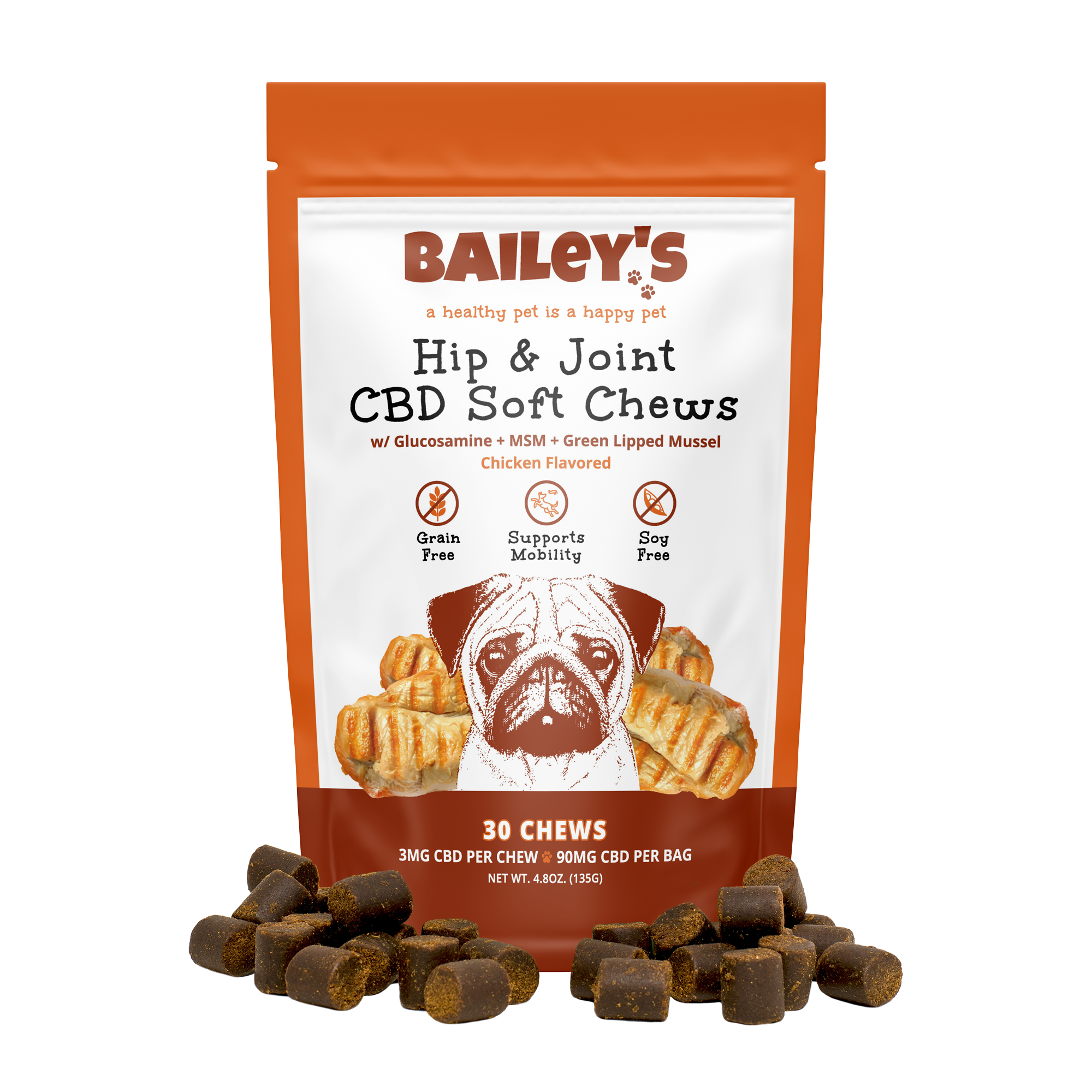Big Fluffy Dog Breeds: Size and Coats

Big Fluffy Dog Breeds: Size and Coats
Big fluffy dog breeds have captured the hearts of dog lovers all over the world. Whether it's their majestic appearance, their soft and cozy coats, or their gentle and lovable nature, these breeds hold a special place in our hearts.
In this article, we will explore the appeal of big fluffy dog breeds, the genetics behind their size and coats, popular breeds in this category, how to properly care for them, and important health considerations. So, let's dive in with the friendly folks from Bailey’s CBD and discover more about these fascinating canines!

Image: A regal-looking Caucasian Shepherd revels in the snow with eyes closed blissfully.
Understanding the Appeal of Big Fluffy Dog Breeds
The Aesthetics of Fluffiness
One of the primary reasons people are drawn to big fluffy dog breeds is their incredibly fluffy coats. These breeds often have thick, dense fur that gives them a fluffy and voluminous appearance. From the moment you lay eyes on a fluffy dog, you can't help but be enraptured by their beauty. Their fluffy coats not only make them visually appealing but also provide insulation, keeping them warm during colder seasons.
Imagine walking through a park on a crisp autumn morning, leaves crunching beneath your feet. As you stroll along, you spot a majestic big fluffy dog, its coat resembling a fluffy cloud. The sunlight dances off its fur, creating a mesmerizing display of colors. You can't resist reaching out to touch its soft, fluffy coat, and as your hand sinks into the plushness, you can't help but smile in delight.
But the appeal of big fluffy dog breeds goes beyond their aesthetics. Their fluffy coats are not just for show; they serve a practical purpose. In the depths of winter, when the biting cold seems to seep into your bones, these dogs become your own portable heater. Their thick fur acts as a natural insulator, keeping them warm and cozy, and in turn, providing you with a warm and comforting presence.
The Comfort Factor: Why Size Matters
Another aspect that makes big fluffy dog breeds so appealing is their size. These breeds are known for their substantial build, often towering above smaller canines. Many people find comfort and security in owning a large dog, as their size can be reassuring and provide a sense of protection. Additionally, their size often translates into a gentle and calm demeanor, making them ideal companions for families and individuals seeking a loyal and affectionate pet.
Imagine coming home after a long and tiring day, feeling drained and weary. As you step through the front door, a big fluffy dog greets you with a wagging tail and a gentle nudge. Its size alone brings a sense of comfort and security as if you have your very own guardian angel watching over you. You sink into the nearest couch, and the dog curls up beside you, its warmth and presence instantly soothing your tired soul.
But it's not just their size that makes big fluffy dog breeds so comforting. Their gentle and calm demeanor adds to their appeal. These dogs have a natural knack for sensing your emotions and providing the right amount of comfort. Whether you're feeling down and in need of a cuddle or simply seeking a loyal companion to share your joys and sorrows, a big fluffy dog will always be there, ready to offer unconditional love and support.

Calming CBD Yummies
Keep your pets calm and happy with these tasty and effective CBD yummies, perfect for any time of the day.
Shop Calming CBD Yummies
Hip & Joint CBD Dog Chews
Support your pet's mobility and joint health with these vet-crafted, CBD-infused chews.
Shop Hip & Joint CBD Dog ChewsThe Genetics Behind Big Fluffy Dog Breeds
The Role of Genes in Determining Size
Unraveling the genetic mysteries behind the size of big fluffy dog breeds is a fascinating pursuit. These dogs have certain genetic traits that predispose them to grow larger than their counterparts. Breeders carefully select dogs with desired size traits to ensure the preservation of these characteristics in successive generations. However, it is important to note that genetics are not the sole factor in determining size, as nutrition and overall health also play significant roles.
When it comes to the genetics of size in big fluffy dog breeds, there are several key genes at play. One such gene is known as the "growth hormone gene," which regulates the production of growth hormone in the body. Dogs with certain variations of this gene tend to have a higher growth potential, resulting in a larger overall size. Another gene that plays a role in determining size is the "insulin-like growth factor 1 gene," which influences the growth and development of bones and tissues. Dogs with specific variations of this gene may have longer and thicker bones, contributing to their larger size.
It is also worth mentioning that the environment in which a dog grows up can have an impact on its size. Adequate nutrition is crucial for proper growth and development, and a well-balanced diet can help ensure that a big fluffy dog breed reaches its full potential in size. Additionally, regular exercise and physical activity can promote healthy muscle development, which can further contribute to a dog's overall size.
The Science of Fluff: How Coats Develop
The development of the luxurious coats that big fluffy dog breeds possess is a combination of genetics, environmental factors, and proper grooming. These breeds often have a double coat, consisting of a dense undercoat and a longer outer coat. The texture and density of their fur are influenced by various genes that determine the production of specific proteins. In addition, regular grooming, including brushing and occasional trims, is essential for maintaining the health and appearance of their coats.
One of the key genes involved in coat development is the "fibroblast growth factor 5 gene," which controls the length and texture of a dog's hair. Dogs with certain variations of this gene may have longer and silkier fur, giving them that signature fluffy appearance. Another gene that plays a role in coat development is the "keratin gene," which determines the strength and structure of the hair. Dogs with specific variations of this gene may have thicker and more resilient fur, adding to their fluffiness.
While genetics provide the foundation for a big fluffy dog breed's coat, environmental factors can also influence its appearance. The climate in which a dog lives can affect the thickness and density of its fur. For example, dogs living in colder climates may develop a thicker undercoat to provide insulation, while those in warmer climates may have a lighter coat. Additionally, proper grooming practices are crucial for maintaining the health and aesthetics of a big fluffy dog breed's coat. Regular brushing helps remove loose hair and prevents matting, while occasional trims can keep the fur looking neat and tidy.
Simply stated, the genetics producing big fluffy dog breeds are complex and fascinating. From determining size to the development of their luxurious coats, genes play a significant role in shaping these beloved canine companions. However, it is important to remember that genetics are just one piece of the puzzle, and factors such as nutrition, environment, and grooming practices also contribute to the overall appearance and well-being of these magnificent dogs.
Popular Big Fluffy Dog Breeds
When it comes to big fluffy dog breeds, there are a few that stand out from the rest. These majestic creatures not only possess an impressive size but also have a gentle nature that makes them beloved companions. Let's explore two of the most popular big fluffy dog breeds in more detail.
The Majestic Newfoundland
The Newfoundland is a breed that has captured the hearts of many dog lovers around the world. These big fluffy dogs are renowned for their gentle and patient temperament, which makes them excellent companions for families and individuals alike. Their impressive size is matched by their thick, water-resistant coat, which not only provides insulation but also helps them excel in water rescue situations.

Image: A sweet-looking black and white Newfoundland lays on the ground.
Originating from the Canadian province of Newfoundland and Labrador, these dogs were originally bred as working dogs for fishermen. Their webbed feet and strong swimming abilities make them natural lifesavers in water. In addition to their rescue skills, Newfoundlands are also known for their calm and composed demeanor, making them ideal therapy dogs.
Despite their large size, Newfoundlands are incredibly gentle with children and other pets. Their patient nature and protective instincts make them excellent family dogs. They are often described as "gentle giants" due to their ability to form strong bonds with their human companions.
The Lovable Old English Sheepdog
Another big fluffy breed that captures the hearts of many is the Old English Sheepdog. With its distinctive shaggy coat, this breed boasts a combination of charm and playfulness that is hard to resist. Their thick white and gray fur not only protects from the elements but also gives them an endearing, teddy bear-like appearance.

Image: A very fluffy, predominately white Old English Sheepdog lays on a carpet with head up alertly.
Originally bred in England for herding livestock, Old English Sheepdogs are known for their intelligence and loyalty. Their herding instincts are still present in some individuals, making them excellent candidates for dog sports such as agility and obedience trials. These dogs thrive on mental and physical stimulation, so engaging them in various activities is essential for their well-being.
Old English Sheepdogs are not only intelligent but also highly adaptable. They can easily adjust to different living situations, whether it's in a spacious countryside home or a cozy city apartment. However, they do require regular grooming to maintain their iconic shaggy coat. Regular brushing and occasional trimming are necessary to prevent matting and keep their fur clean and healthy.
When it comes to temperament, Old English Sheepdogs are known for their friendly and affectionate nature. They form strong bonds with their families and are great with children. Their playful and clownish behavior often brings joy and laughter to those around them.
These are only two of numerous examples of popular big fluffy dog breeds, each with unique traits and characteristics. Whether you're drawn to the gentle and patient nature of the Newfoundland or the lovable charm of the Old English Sheepdog, one thing is for sure - these big fluffy dogs will always have a special place in our hearts.

🐶 Unleash Comfort: No More Itchies Probiotic Dog Chews 🥓
Treat your pup to Bailey's No More Itchies Probiotic Dog Chews, the ultimate bacon-flavored solution for itchy, irritated skin. Each chew is crafted to provide the itch relief your dog needs to stay comfortable and happy.
- Skin Comfort: Eases irritation and reduces itching.
- Digestive Health: Supports gut flora and boosts immunity.
- Bacon Flavored: Irresistible taste dogs love.
Caring for Big Fluffy Dog Breeds
Grooming Needs of Fluffy Coats
One of the key aspects of caring for big fluffy dog breeds is proper grooming. Regular brushing is essential to prevent matting and to keep their coats healthy and free from debris. Additionally, periodic baths using dog-specific shampoos formulated for their unique coat needs will help maintain the overall cleanliness and luster of their fur.
Dietary Requirements for Large Breeds
Proper nutrition is vital for the well-being of all dogs, and big fluffy breeds are no exception. These dogs have unique dietary requirements due to their size and activity levels. It is important to provide them with a balanced diet that is appropriate for their specific breed and age. High-quality dog food, tailored to meet the nutritional needs of larger breeds, will help ensure their overall health and maintain their beautiful coats. Consult your dog’s favorite veterinarian if you have questions about diet or adding supplements or treats to aid in the overall well-being of your fluffy canine friend.
Health Considerations for Big Fluffy Dog Breeds
Common Health Issues in Large Dogs
While big fluffy dog breeds are generally healthy, certain health conditions are more prevalent in larger breeds. Some common health issues include hip dysplasia, obesity, and certain joint and bone disorders. Regular exercise, a balanced diet, and routine veterinary check-ups can help manage and prevent these health concerns.
Lifespan and Aging in Big Fluffy Breeds
Like all dogs, big fluffy breeds also have a distinct lifespan and aging process. On average, larger breeds tend to have a shorter lifespan compared to smaller breeds. It is important to provide them with appropriate veterinary care throughout their lives, including regular check-ups, vaccinations, and screenings for age-related conditions.
🐾 Discover the Benefits of Bailey's CBD for Pets!
Support your pet's health with Bailey’s premium wellness products, trusted by veterinarians and pet owners alike. Our solutions are designed for calmness, joint support, and overall well-being.

Conclusion
Big fluffy dog breeds have an undeniable charm, with their size and fluffy coats capturing the hearts of many. Understanding the appeal, genetics, and care requirements of these breeds allows us to appreciate their beauty and provide them with the love and attention they deserve. From the majestic Newfoundland to the lovable Old English Sheepdog, these breeds offer companionship, loyalty, and endless joy to those fortunate enough to share their lives with them.📰 Related Dog Breed Articles 🐕
- 🐕 Appearance and Characteristics of the Short Hair Border Collie
- 🐕 Airedale: Breed Traits and Overview
- 🐕 Tibetan Terrier: Canine Breed Insights
- 🐕 American Bully: Breed Profile and Traits
- 🐕 Turkish Dog Breeds: Canine Diversity
- 🐕 English Shepherd: Canine Breed Overview
- 🐕 German Pinscher: Breed Traits and Characteristics
- 🐕 Australian Shepherds and Cats: Canine-Feline Interaction
These products have not been evaluated by the FDA and are not intended to diagnose, treat, cure, or prevent any disease.














